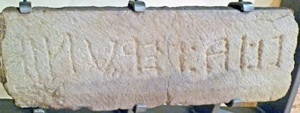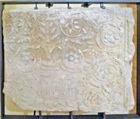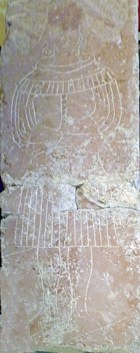

The archeological museum of Montefalco is housed in the crypt of the ex-church of San Francesco.
Funerary Inscription (ca. 100 BC)

This inscription on the lid of a cinerary urn, which uses an Etruscan alphabet, was found recently in Vecciano. It reads from right to left:
vi: ia: perunia
Vibio Perunia, the son of Ianto
(See also the page on Umbrian Inscriptions after 295BC).
Inscription (1st century BC)
This fragment, which contains the last two lines of a funerary inscription, was moved to the museum from San Fortunato in ca. 1930. It reads:
VARIA CN[AEI] F[ILIA]
OSSURA
The lady Varia belonged to the gens Varius or Varianus, the family that gave its name to the locality of San Fortunato for a considerable period: for example:
-
✴Duke Lupus of Spoleto issued diplomas from the nearby castrum, “curte nostra ad Varianum”(our court at Varianum) in 749 and 750; and
-
✴a certain Andrea Andrea and his wife Casalina sold “petiam terre vincale in curtis castri Coronii, in loco qui dicitur Vagiano” (a piece of land in the court of the fortress of Coronii, in the locality called Vagiano) to Angolarlo, a judge at Coccorone, in 1204.
The significance of the word “ossura” is unclear: it could be a cognomen, but more probably relates to the funerary context (“os” is the Latin word for bone).
Caius Aufidius Agroecus (early imperial period ?)
This inscription from an unknown location reads:
------?
C(aius) Aufidiu[s C(ai) l(ibertus)]/ Agroec[us]
mag(ister) Va[l(etudinis)]
P(---) O(---) [---?]
This freedman, who was also a a member of the municipal magistracy of the Magistri Valetudinis at Mevania, is known from another inscription (CIL XI 5040) from Mevania (Bevagna).
Relief (1st century AD)

Funerary altar (1st century AD)

Hercules (late 1st century AD)

The hero carries the skin of the Nemean lion, which he had killed as one of the twelve labours that he undertook in penance for murdering his children. [Two worms hang from his hair].
Funerary altar (late 1st century AD)

Lion (1270)

Monument to a Knight (late 14th century)


